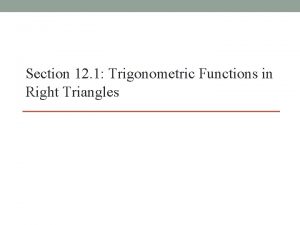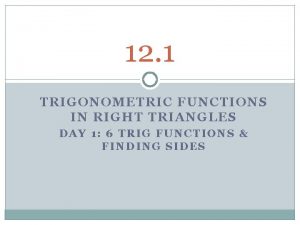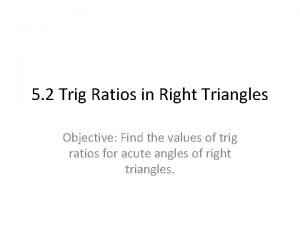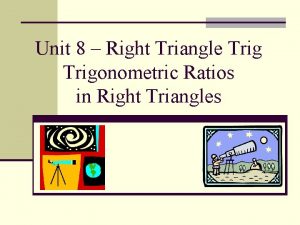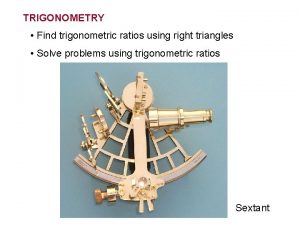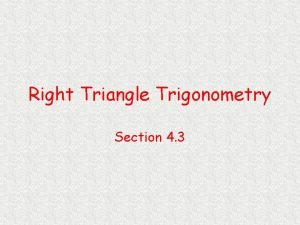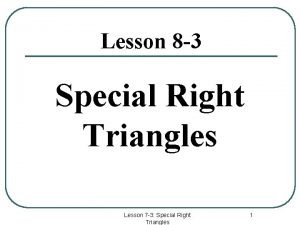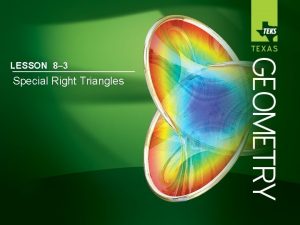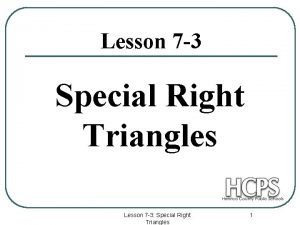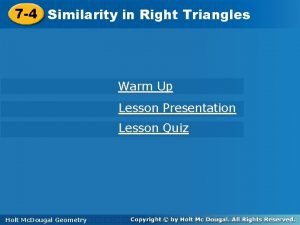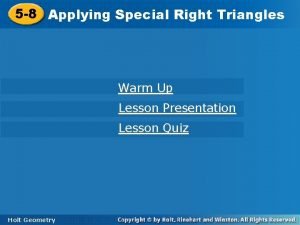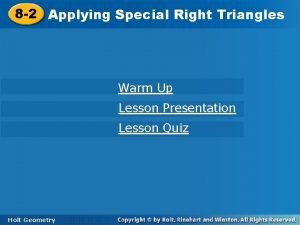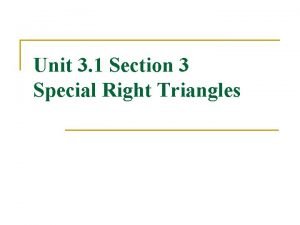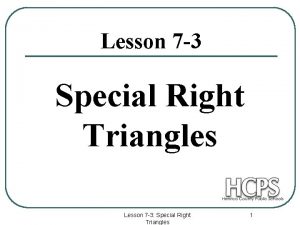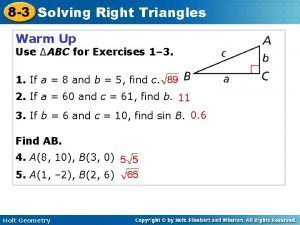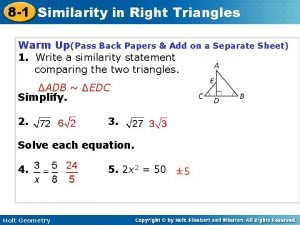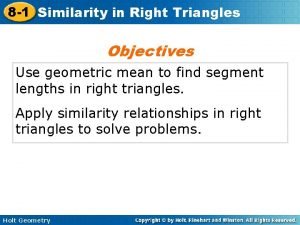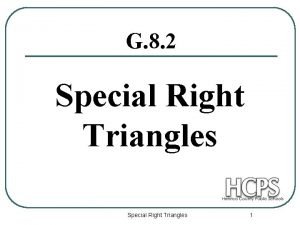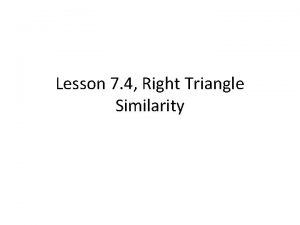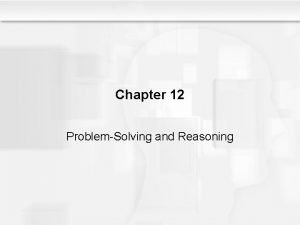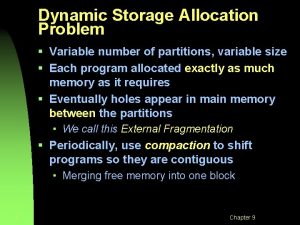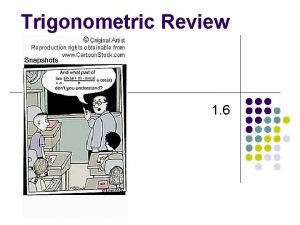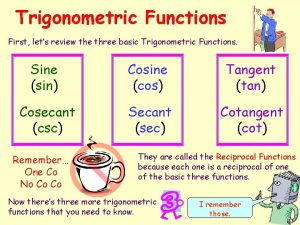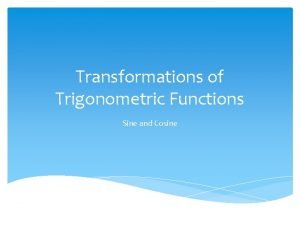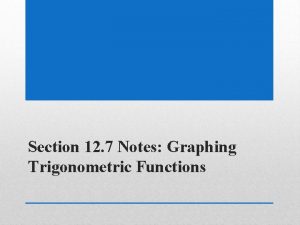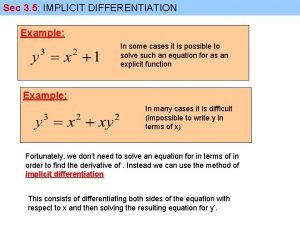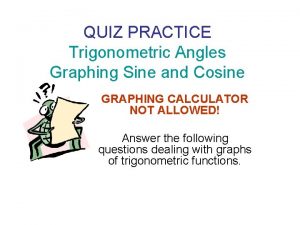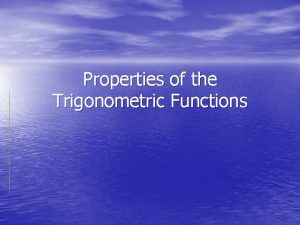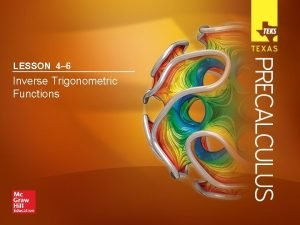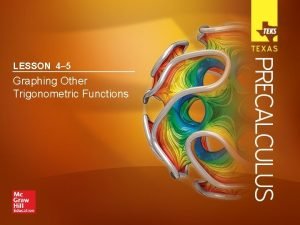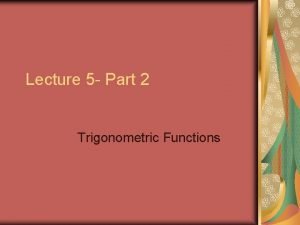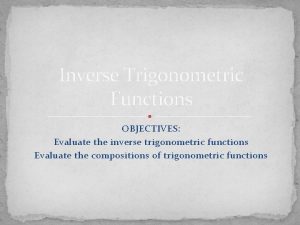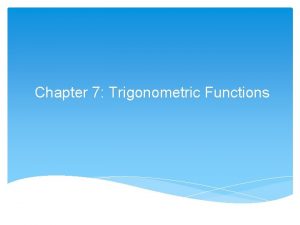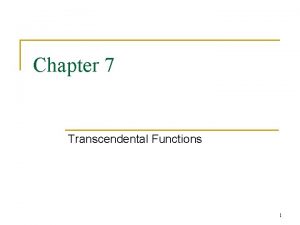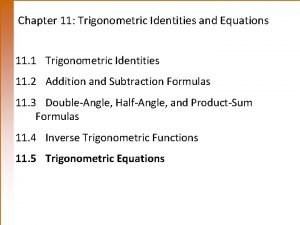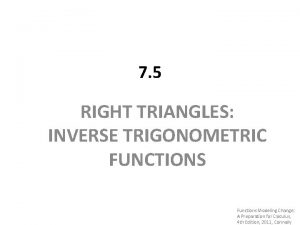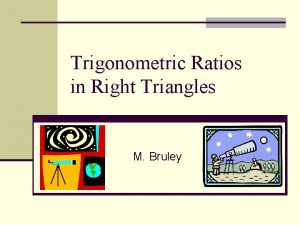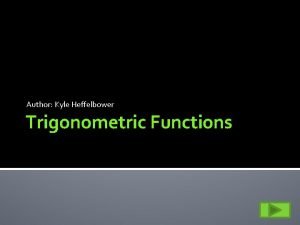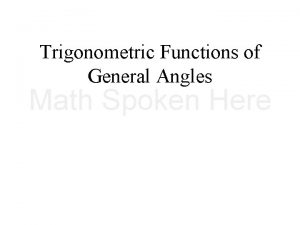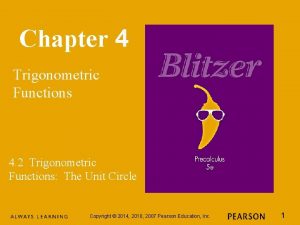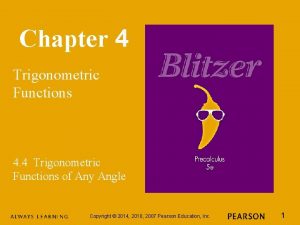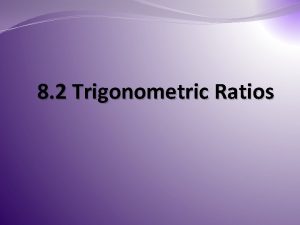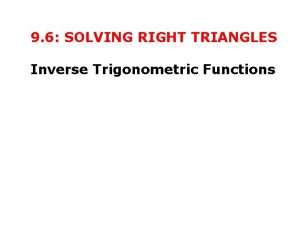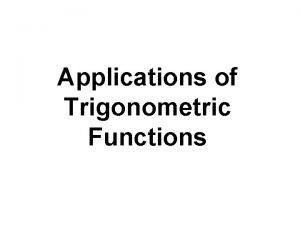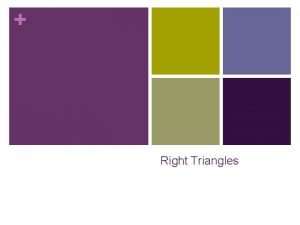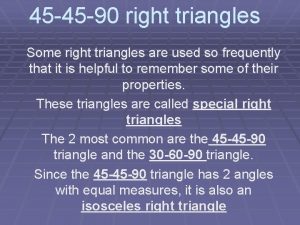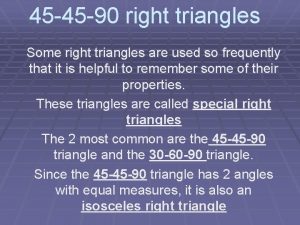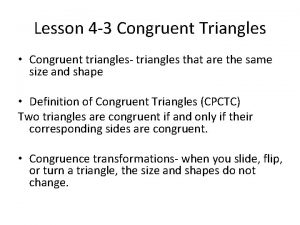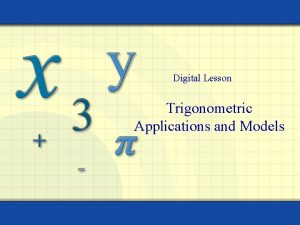You solved right triangles using trigonometric functions Lesson












































- Slides: 44


You solved right triangles using trigonometric functions. (Lesson 4 -1) Solve oblique triangles by using the Law of Sines. Solve oblique triangles by using the Law of Cosines. Find areas of oblique triangles using Heron’s Formula.

• oblique triangles • Law of Sines • ambiguous case • Law of Cosines • Heron’s Formula


Apply the Law of Sines (AAS) Solve ΔLMN. Round side lengths to the nearest tenth and angle measures to the nearest degree. Because two angles are given, N = 180 o – (112 o + 29 o) or 39 o. Use the Law of Sines to find m and n.

Apply the Law of Sines (AAS) Law of Sines Substitution Multiply. Divide. Use a calculator. Therefore, N = 39°, m ≈ 42. 1, n ≈ 28. 6 Answer: N = 39°, m ≈ 42. 1, n ≈ 28. 6

Solve ΔXYZ. Round side lengths to the nearest tenth and angle measures to the nearest degree. A. y ≈ 11. 8, z ≈ 8. 0, Y = 75° B. y ≈ 8. 0, z ≈ 5. 3, Y = 85° C. y ≈ 28. 7, z ≈ 18. 9, Y = 95° D. y ≈ 14. 6, z ≈ 9. 9, Y = 75°

Apply the Law of Sines (ASA) BALLOONING The angle of elevation from the top of a building to a hot air balloon is 62º. The angle of elevation to the hot air balloon from the top of a second building that is 650 feet due east is 49º. Find the distance from the hot air balloon to each building. Draw a figure showing the situation.

Apply the Law of Sines (ASA) Because two angles are given, Z = 180° – (62° + 49°) or 69°. Use the Law of Sines to find the distance to the balloon from each building. Law of Sines Substitution Multiply. Divide.

Apply the Law of Sines (ASA) x ≈ 525. 5 Use a calculator. y ≈ 614. 7 So, the balloon is about 525. 5 feet from the first building and 614. 7 feet from the second building. Answer: about 525. 5 ft; 614. 7 ft

TREE A tree is leaning 10° past vertical as shown in the figure. A wire that makes a 42° angle with the ground 10 feet from the base of the tree is attached to the top of the tree. How tall is the tree? A. 6. 8 ft B. 7. 8 ft C. 14. 3 ft D. 10. 9 ft


The Ambiguous Case—One or No Solution A. Find all solutions for the given triangle, if possible. If no solution exists, write no solution. Round side lengths to the nearest tenth and angle measures to the nearest degree. A = 63°, a = 18, b = 25 Notice that A is acute and a < b because 18 < 25. Find h.

The Ambiguous Case—One or No Solution Definition of sine h = b sin A or about 22. 3 Because a < h, no triangle can be formed with sides a = 18, b = 25, and A = 63°. Therefore, the problem has no solution. Answer: no solution

The Ambiguous Case—One or No Solution B. Find all solutions for the given triangle, if possible. If no solution exists, write no solution. Round side lengths to the nearest tenth and angle measures to the nearest degree. A = 105°, a = 73, b = 55 Notice that A is obtuse and a > b because 73 > 55. Therefore, one solution exists. Apply the Law of Sines to find B.

The Ambiguous Case—One or No Solution Law of Sines Multiply each side by 55. Definition of sin– 1 B ≈ 46. 7° Use a calculator. Because two angles are now known, C ≈ 180° – (105° – 46. 7°) or about 28. 3°. Apply the Law of Sines to find c. Choose the ratios with the fewest calculated values to ensure greater accuracy.

The Ambiguous Case—One or No Solution Law of Sines Solve for c. Therefore, the remaining measures of ΔABC are B ≈ 47°, C ≈ 28°, c ≈ 35. 8. Answer: B ≈ 47°, C ≈ 28°, c ≈ 35. 8

Find all solutions for ΔABC where a = 18, b = 13, and A = 126 o, if possible. If no solution exists, write no solution. Round side lengths to the nearest tenth and angle measures to the nearest degree. A. B ≈ 42°, C ≈ 12°, c ≈ 4. 6 B. B ≈ 28°, C ≈ 26°, c ≈ 9. 8 C. B ≈ 36°, C ≈ 18°, c ≈ 6. 9 D. no solution

The Ambiguous Case-Two Solutions Find two triangles for which A = 45°, a = 18, and c = 24. Round side lengths to the nearest tenth and angle measures to the nearest degree. A is acute, and h = 24 sin 45 o or about 17. 0. Notice that a < c because 18 < 24, and a > h because 18 > 17. 0. Therefore, two different triangles are possible with the given angle and side measures. Angle C will be acute, while angle C' will be obtuse.

The Ambiguous Case-Two Solutions Make a reasonable sketch of each triangle and apply the Law of Sines to find each solution. Start with the case in which C is acute. Solution 1 C is acute. Find C. Law of Sines Definition of sin– 1 Use a calculator. Solve for sin C.

The Ambiguous Case-Two Solutions Find B. B ≈ 180° – (70. 48° + 45°) or about 64. 52° Apply the Law of Sines to find b. Law of Sines

The Ambiguous Case-Two Solutions Solution 2 C' is obtuse. Note that m BC'C m BCC'. To find C', you need to find an obtuse angle with a sine that is also 0. 9425. To do this, subtract the measure given by your calculator to the nearest degree, 70. 48 o, from 180 o. Therefore, C' is approximately 180 o – 70. 48 o or 109. 52 o. Find B. B ≈ 180° – (109. 52° + 45° ) or 25. 48

The Ambiguous Case-Two Solutions Apply the Law of Sines to find b. Law of Sines Solve for b. Therefore, the missing measures for acute ΔABC are B ≈ 65°, C ≈ 70°, and b ≈ 23. 0, while the missing measures for obtuse ΔABC' are B ≈ 25°, C ≈ 110°, and b ≈ 11. 0 Answer: B ≈ 65°, C ≈ 70°, b ≈ 23. 0; B ≈ 25°, C ≈ 110°, b ≈ 11. 0

Find two triangles for which A = 24°, a = 13, and b = 15. Round side lengths to the nearest tenth and angle measures to the nearest degree. A. B ≈ 128°, C ≈ 28°, c ≈ 15. 0, B ≈ 4°, C ≈ 152°, c ≈ 17. 3 B. B ≈ 28°, C ≈ 128°, c ≈ 25. 2, B ≈ 152°, C ≈ 4°, c ≈ 2. 2 C. B ≈ 28°, C ≈ 128°, c ≈ 25. 2, B ≈ 62°, C ≈ 92°, c ≈ 31. 9 D. B ≈ 21°, C ≈ 135°, c ≈ 22. 6, B ≈ 69°, C ≈ 87°, c ≈ 31. 9


Apply the Law of Cosines (SSS) LANDSCAPING A triangular area of lawn has a sprinkler located at each vertex. If the sides of the lawn are a = 19 feet, b = 24. 3 feet, and c = 21. 8 feet, what angle of sweep should each sprinkler be set to cover? Since three side lengths are given, you can use the Law of Cosines to find the largest angle, B. b 2 = a 2 + c 2 – 2 ac cos B Law of Cosines 24. 32 = 192 + 21. 82 – 2(19)(21. 8)c os B a

Apply the Law of Cosines (SSS) 590. 49 = 361 + 475. 24 – 828. 4 cos B Simplify. 590. 49 = 836. 24 – Divide 828. 4 cos B each side by Add. – 828. 4. – 245. 75 = – 828. 4 Use cos – 1 the B cos Subtract function. 836. 24 from each side.

Apply the Law of Cosines (SSS) Use a calculator. Use the Law of Sines to find A. Law of Sines Then, find C. C ≈ 180° – (72. 7° + 48. 3°) C ≈ 59. 0° Solv e for A.

Apply the Law of Cosines (SSS) The angle of sweep for A is about 48°, the angle of sweep for B is about 73°, and the angle of sweep for C is about 59°. Answer: A ≈ 48°, B ≈ 73°, C ≈ 59°.

LOT A triangular lot has sides of 120 feet, 186 feet, and 147 feet. Find the angle across from the shortest side. A. 9° B. 40° C. 49° D. 52°

Apply the Law of Cosines (SAS) Solve ΔABC. Round side lengths to the nearest tenth and angle measures to the nearest degree.

Apply the Law of Cosines (SAS) Step 1 Use the Law of Cosines to find the missing side measure. a 2 = b 2 + c 2 – 2 bc cos A Law of Cosines a 2 = 122 + 142 – 2(12)(14)cos 39. 4º b = 12, c = 14, and A = 39. 4 o a 2 ≈ 80. 36 a ≈ 9. 0 Use a calculator. Take the positive square root of each side.

Apply the Law of Cosines (SAS) Step 2 Use the Law of Sines to find a missing angle measure. Multiply each side by 12. B ≈ 57. 8° Definition of sin– 1

Apply the Law of Cosines (SAS) Step 3 Find the measure of the remaining angle. C ≈ 180° – (39. 4° + 57. 8°) or 82. 8° Therefore, a ≈ 9. 0, B ≈ 58°, and C ≈ 83°. Answer: a ≈ 9. 0, B ≈ 58°, C ≈ 83°

Solve ΔMNP if M = 54 o, n = 17, and p = 12. Round side lengths to the nearest tenth and angle measures to the nearest degree. A. m ≈ 193. 2, N ≈ 4°, P ≈ 122° B. m ≈ 13. 9, N ≈ 82°, P ≈ 44° C. m ≈ 17. 7, N ≈ 51°, P ≈ 75° D. m ≈ 16. 1, N ≈ 59°, P ≈ 67°


Heron’s Formula Find the area of ΔABC to the nearest tenth. . Heron's Formula s = 72, a = 47, b = 53, and c = 44

Heron’s Formula Simplify. Use a calculator. Answer: about 978. 6 ft 2

Find the area of ΔGHJ. A. 2790. 1 ft 2 B. 678. 0 ft 2 C. 191. 6 ft 2 D. 31. 9 ft 2


Find the Area of a Triangle Given SAS Find the area of ΔABC to the nearest tenth. In ΔABC, b = 39, c = 52, and A = 25. 89 o. Area of a triangle using SAS Substitution. Simplify.

Find the Area of a Triangle Given SAS So, the area is about 442. 8 in 2. Answer: about 442. 8 in 2

Find the area of ΔDEF to the nearest tenth. A. 652. 4 cm 2 B. 326. 2 cm 2 C. 224. 6 cm 2 D. 112. 3 cm 2

 12-1 trigonometric functions in right triangles
12-1 trigonometric functions in right triangles 12-1 trigonometric functions in right triangles
12-1 trigonometric functions in right triangles Right product right place right time right price
Right product right place right time right price Family time
Family time 5-2 trigonometric ratios in right triangles
5-2 trigonometric ratios in right triangles 60 3090 triangle
60 3090 triangle Magic triangle trigonometry
Magic triangle trigonometry You put your left foot in you put your left foot out
You put your left foot in you put your left foot out The right man on the right place at the right time
The right man on the right place at the right time Csc in triangle
Csc in triangle Special right triangles 8-3
Special right triangles 8-3 8-3 special right triangles answers
8-3 special right triangles answers Hyp opp adj
Hyp opp adj Lesson 7-3 special right triangles
Lesson 7-3 special right triangles 7-4 similarity in right triangles
7-4 similarity in right triangles Applying special right triangles answer key
Applying special right triangles answer key Applying special right triangles
Applying special right triangles Unit 3 lesson 2 special right triangles
Unit 3 lesson 2 special right triangles 8-2 special right triangles
8-2 special right triangles Special right triangles
Special right triangles Lesson 8-3 solving right triangles
Lesson 8-3 solving right triangles 8 3 solving right triangles
8 3 solving right triangles Write a similarity statement comparing the two triangles.
Write a similarity statement comparing the two triangles. Lesson 8-1 similarity in right triangles
Lesson 8-1 similarity in right triangles Right triangle sides
Right triangle sides Altitude
Altitude In vivo problem solving
In vivo problem solving Dynamic storage allocation problem
Dynamic storage allocation problem Cos90
Cos90 Three basic trigonometric functions
Three basic trigonometric functions Trig functions transformations
Trig functions transformations Graph sine and cosine functions
Graph sine and cosine functions 12-7 graphing trigonometric functions answers
12-7 graphing trigonometric functions answers Differentiate trigonometric
Differentiate trigonometric Graphing sine and cosine functions quiz
Graphing sine and cosine functions quiz Domain and range of tangent
Domain and range of tangent Limits of trigonometric functions
Limits of trigonometric functions Arctan(1) exact value
Arctan(1) exact value 4-5 graphing other trigonometric functions answers
4-5 graphing other trigonometric functions answers Parts of trigonometric functions
Parts of trigonometric functions Domain and range of trigonometric functions
Domain and range of trigonometric functions How to remember derivatives of inverse trig functions
How to remember derivatives of inverse trig functions Period of trigonometric functions
Period of trigonometric functions Integration of inverse trigonometric functions
Integration of inverse trigonometric functions Trig equations
Trig equations
